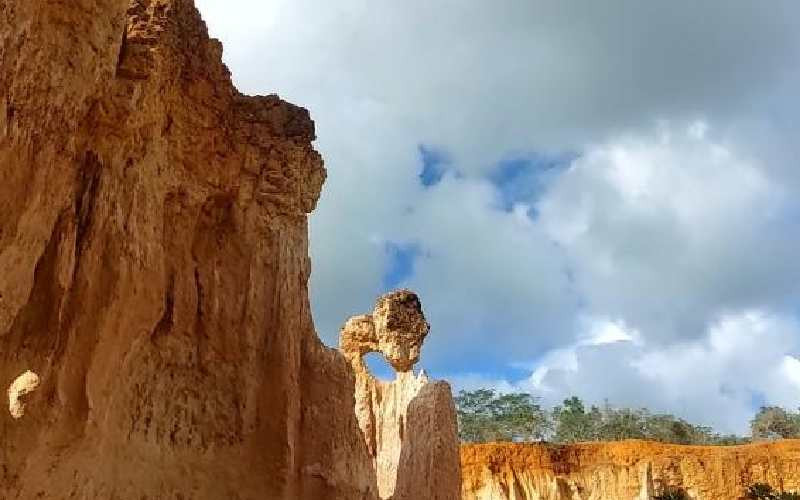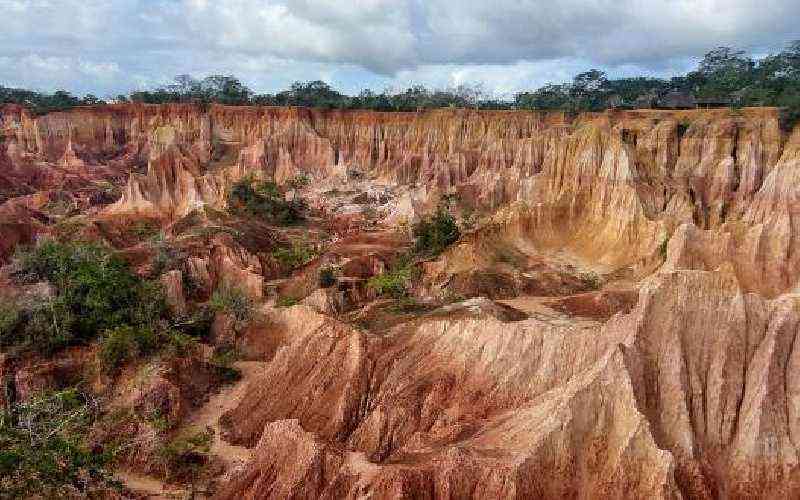
The colourful sandstone pillars form Hell's Kitchen. [Jayne Rose Gacheri, Standard]
The drive from Malindi to Marafa felt mythical. It reminded me of my history lessons back then - the history of the coastal strip, the sultans, the Swahili people and the local Miji Kenda.
As you hit the Malindi-Magarini-Marafa highway, spread out on both sides of the road are hundreds of acres of land dotted with green maize.
Considering the ongoing drought, these farmers must be counting their lucky stars.
After a 40-minute Tuk-Tuk drive, we are at Marafa. We stop to buy water and some snacks for our three-hour anticipated Hell's Kitchen hike. A while later, we check at the reception of Hell's Kitchen and pay a Sh300 entry fee, and a Sh1,000 guide fee (the guide fee is negotiable). Ten minutes later, guide Kazungu Tuva walks us to the observation point.
We stand on the edge of what seems to be a deep colourful beautiful valley, with sand pillars rising at 30 metres above the floor as if to impress the onlooker.
It is out of this world, and indescribable. I am astounded by its splendour. I am "love-struck" by this masterpiece of nature's artistry!
The spectacle reminds me of Death Valley, in California, one of the world's driest places.
As if reading my mind, Kazungu taps my shoulder and announces it is time to explore Hell's Kitchen. As we prepare to "walk the path to Hell's Kitchen", the guide warns me; "the heat down there is to be taken seriously," prompting me to take off my sweater and take some water.
Even though I had read about Hell's Kitchen, nothing had prepared me for the excitement provoked by this underrated site that is in essence nature's work at its best.
Coming alive, is a clear picture of what I had read: "a place broken by itself forming a depression in an outstanding site of stalactites, (spikes), and stalagmites (pillars) formed through the process of wearing away the limestone rock."
The layers of cake-like colour of the sandstones are outstanding whites, pinks, oranges, and deep crimsons, which make the gorge striking.
Kazungu explains that Hell's Kitchen is a masterpiece, especially at sunset when tones of the ribbed sandstone gullies "come alive" with the colours highlighted and mirrored by those of the setting sun.
The descent happens in minimal steepness, so you do not realise how deep you have descended several feet from the viewing edge of the canyon - the temperatures can reach a scalding 50 degrees Celsius.
However, on this day, on checking with Google I get to know that today's temperatures are within the range of 45 degrees Celsius at the highest.
"The temperatures can be quite high and unbearable, which probably is why this canyon is referred to as Hell's Kitchen," guide Kazungu says.
Our hike is leisurely and relaxed, occasionally punctuated by a few difficult tracks that sometimes had me almost crawling on my knees, making it all fun. In between, we stop to view a feature that the guide points out as he explains it.
Sometimes we took a breather to admire the many shades of colours, all with a different meaning believed from a legend in the past.
The story of Hell's Kitchen is one of myths vs reality. There are many myths (depending on who your guide is), some of which will "crack" your mind. One of the myths has it that once upon a time, a town is located on where the gorge is now.
One day, all of the town's inhabitants received a vision telling them of a disastrous happening that would befall the town. The dwellers had to live in the town. Everyone, except one old woman, headed to the command. Later the town mysteriously disappeared with the woman, leaving behind a great depression.

A legend has it that a long time ago, there lived a wealthy family in the present-day Marafa Village. The family-owned vast land and kept livestock. The wealth kept multiplying each year. However, the family had challenges with the scarcity of water. Faced with having to trek long distances to get the rare commodity, it opted to use milk for its domestic use.
Divine wrath
However, this act angered God so much, because many of this family's neighbours lacked food. He released an enormous storm that "swallowed" this family, thereby creating a deep chasm that engulfed the family and made the place so hot, making it completely inhospitable for man - thus the present-day, Marafa Hell's Kitchen.
Tuva explained that the gorges are also used as a prayer site where Kaya (shrine) elders give offerings to God. The locals believe that it is divine wrath.
Scientific reality nevertheless, has it that Hell's Kitchen was once a great sandstone ridge worn out by wind, rain, and floods into a series of jagged gorges. The feature, they say is geographical formations.
The Marafa depression is a series of sun-baked gorges and tall chimney-like structures with some rising to 30 metres high. The phenomenon structures have been perfectly formed by water and wind erosion over decades. There is evidence that this action is still happening.
"The red-like hills are the blood of the family punished by God for the waste done, the whites are the colour of milk wasted by the family, while the yellow ones are the colour of God's wrath towards the family," says the guide.
I have finally ticked off Hell's Kitchen" from my adventure bucket list.
 The Standard Group Plc is a multi-media organization with investments in media
platforms spanning newspaper print
operations, television, radio broadcasting, digital and online services. The
Standard Group is recognized as a
leading multi-media house in Kenya with a key influence in matters of national and
international interest.
The Standard Group Plc is a multi-media organization with investments in media
platforms spanning newspaper print
operations, television, radio broadcasting, digital and online services. The
Standard Group is recognized as a
leading multi-media house in Kenya with a key influence in matters of national and
international interest.









